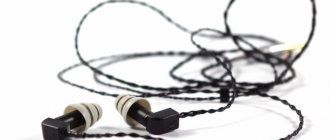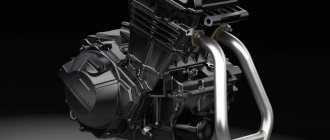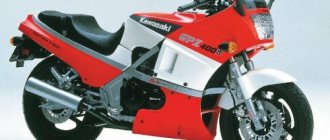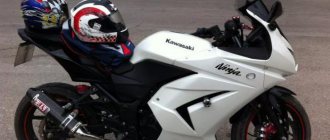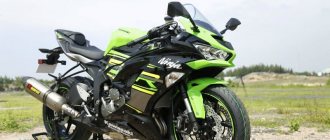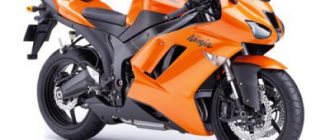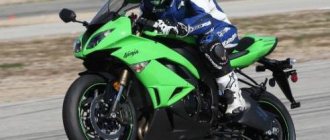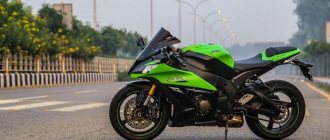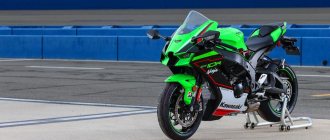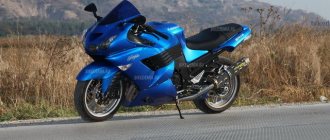| Kawasaki Ninja 400 (2018+) |
Model of the budget sports motorcycle Kawasaki Ninja 400
appeared on the market in 2021, replacing the Kawasaki Ninja 300. The new model, compared to its predecessor, received a redesigned appearance, a new dashboard, engine and chassis (new wheel size, new brake system, modified suspension settings).
Factory designation - EX400G
.
The Kawasaki Ninja 400 (2018+) was based on an in-line 2-cylinder liquid-cooled engine with a volume of 398 cm³ and producing 45 hp. power and 38 Nm of torque. Maximum performance - at 8000-10000 rpm.
The model is officially available in the markets of Japan, Europe and North America. The new Kawasaki Ninja 400 also replaced the domestic Japanese ER-4 series, which in different years included the naked Kawasaki ER-4N and sport-touring versions of the Kawasaki Ninja 400R (in addition to Japan, they were available in the markets of Canada and New Zealand) / Kawasaki Ninja 400 (is restyled version of the Ninja 400R, offered from 2014 to 2021).
In 2021, a naked model, the Kawasaki Z400, was built based on the Ninja 400.
From 2021, the model does not change significantly, but changes its factory designation to EX400H
.
The main competitors of the Kawasaki Ninja 400 (2018+) in the class:
- Honda CBR400R
Brief history of the model
- 2018 - start of production and sales.
Model:
Kawasaki Ninja 400 (Japan, Europe, North America).
Factory designation:
EX400GJF, EX400GJFA, EX400GJFB
- 2019 - no significant changes.
Model:
Kawasaki Ninja 400 (Japan, Europe, North America).
Factory designation:
EX400GKFA, EX400GKFB
- 2020 - no significant changes.
Model:
Kawasaki Ninja 400 (Japan, Europe, North America).
Factory designation:
EX400GLFA
- 2021 - no significant changes.
Model:
Kawasaki Ninja 400 (Japan, Europe, North America).
Factory designation:
EX400HMFNN
- 2022 - the model is not presented on the European market.
Model:
Kawasaki Ninja 400 (Japan, Australia, North America).
Factory designation:
EX400HNFNN
Greetings, gentlemen motorcyclists! Today on the agenda is the dream of boys from the 90s: the second generation Kawasaki ZXR400 (L-series).
Below the cut are traditionally beautiful photos and a lot of letters. Stock up on tea, cookies and don’t forget about pluses and likes.
The Kawasaki concern has released only two generations of this motorcycle. The first was designated by the letter H and was produced for only two years - from 1989 to 1990. You can recognize such motorcycles by their two characteristic separate round headlights. But the second, designated by the letter L, lasted on the assembly line for 12 years - from 1991 to 2003. And without any special changes, only at the end of 99 the engine was slightly tweaked. Although between the first and second generations there were, of course, quite a lot of changes! The L-k not only has a different, more beautiful body kit with headlights combined under a hood, but also a new frame and engine. Second-generation motorcycles develop slightly less torque, but at the same time produce 2 more horsepower, and there are 64 of them in the 400 cc Zahara engine.
Of course, there were other versions of the motorcycle. I'm talking about single-seat racing options. In the first generation they were designated by the letter J, and in the second by the letter M. Naturally, in addition to the seats, there were other differences: fully adjustable forks and monoshock absorbers, a gearbox with close ratios and flat-throttle racing carburetors. Maybe something else too. But it’s simply impossible to find such motos - they have long become collector’s items. For Russia, even ordinary Zakhars are a rarity.
That’s why I was looking for my motorcycle almost all winter at the turn of 2015 and 2021. I reviewed in person almost all the motorcycles that were on sale at that time in Moscow and the surrounding area and eventually found the very same one.
From a conversation with the previous owner Sergei, it was immediately clear that the motorcycle had been looked after. In fact, this was the first Zakhar from whom nothing fell off during the inspection and nothing leaked from under him. We quickly agreed.
Naturally, because The temperature outside was still around zero, so I didn’t try to ride Zakhara right away. Instead, I sent it to Max (my motorcycle mechanic friend) for pre-season service, because... already in early spring the motorcycle had to go to Belgorod for the first stage of XBikes. First of all, we changed the oil, coolant and brake fluids, cleaned and synchronized the carburetors. Then I ordered new Metzeler Racetec RR (K3) track semi-slick tires because... the previous owner decided not to sweat it and put a wide 180 cylinder from a 600 on the rear wheel. By the way, finding tires in the sizes required for Zakhar was very difficult. In the end, the front one still had to be installed with the 70 profile traditional for modern 600s, instead of the recommended 60. It is now simply impossible to find a tire in size 120/60 R17. And the rear tire was registered in the size recommended by the passport 160/60 R17.
Next, Max and I decided to immediately remove the cylinder head cover to check and adjust the valve clearances. And this was truly a fateful decision, which essentially saved the motorcycle engine. We found a very interesting picture in the head - 2 cracked aluminum parts: an oil supply pipe located above the timing chain tensioner and the second of four camshaft cover, through which oil is supplied to it.
It turned out that this is a real disease of the Zakharov 400s, caused by metal fatigue and, in some cases, the crookedness of the craftsmen who do not follow the order of tightening the bolts when servicing the gas distribution mechanism. In the profile public, the entire wall was littered with calls for help in solving this problem. Naturally, I immediately started looking for stores or dismantling shops where I could order these parts. And I very quickly found the pipe and bought it from one of the Moscow region sugar growers. But with cover number 2, unrealistic problems arose. She was not present either at the showdown or on the forums. I started surfing on eBay and foreign forums, but I couldn’t find the ill-fated cover there either. I wanted to order a new one, but it could only be purchased complete with a head at the price of half a motorcycle! In complete despair, I turned to my friend Misha Kabaev, a welder from God. And, imagine, Micah was able to weld this small part with argon so carefully that the internal oil channel did not become even a millimeter narrower. To say that at that moment I was delighted is to say nothing.
Naturally, we also had to cover the holes in the flexible inertial boost pipes with black tape. These are the famous plastic horns protruding from the tank, by which the ZXR series motorcycles are unmistakably recognizable. There is still no sense from them, other than whipping up racing pathos. Unfortunately, after 25 years they inevitably dry out and burst, and it is impossible to find these parts in a fresh state.
We assembled the motik in a hurry on the last night before sending it to Belgorod. It was also necessary to change the torn cylinder head gasket, but in the end I had to stupidly seal it with sealant for a while until the ordered new gasket arrived from abroad.
The next morning I woke up early and went to the garage to get a motorcycle so that before work I could take it to the service guys who were engaged in delivery to Belgorod. But yesterday's haste was not in vain. As soon as I rolled out the motorcycle and opened the fuel tap, it began to fill everything around with gasoline. The seal has leaked. Moreover, the choke cable was unscrewed. The fact is that some crazy Japanese came up with an unrealistically poor idle adjustment for Zakhar. It consisted of a long flexible cable with a gear at the end, which could be turned with the right hand in one direction or the other. The cable was not fixed in the extreme positions and, accordingly, easily twisted and fell out of the groove.
And this whole situation finished me off! Left alone with a motorcycle peeing and stalling at idle, I realized that Belgorod was no longer in the cards for me.
Of course, the Zakharovs have other problems. Chain tensioners often fail, generators burn, and clutch release bearings fly. Of course, here we must also include all the standard stories inherent in every old motorcycle that has been poorly maintained - loose bearings in the wheels, air leaks due to cracked rubber bands in the carburetors, which is manifested by the revolutions slowly falling after closing the throttle, torn damper rubber bands of the rear wheel and etc. In general, you need to choose the ZXR400 incredibly carefully.
I finally made it to the track. And only there I realized two things: that Zakhar is really one of the fastest 400s. I would say “the best,” but, unfortunately, I haven’t ridden RVF and Jixer yet. If anyone can borrow these models for my reviews, I would be incredibly grateful. And secondly, the idea of buying Zakhara to participate in motorcycle racing was a failure. First things first.
The ZXR400 actually felt like a noticeably faster bike than the Sibikha 400 I once owned. Although according to the passport there is only 11 hp between them. and about 20 kg of mass. Zakhar produced 64 hp. at 13,000 rpm, and weighed approximately 180 kg in running order. Yes, up to 8000 it didn’t move at all and became dull when the gas was sharply opened, but from 8000 to the red zone it sang and accelerated like a real racing bike from the 90s. Another plus is that when exiting turns onto a straight line, you could always turn the throttle immediately and all the way. The grip of the Metzeler tires, combined with the compact size of the Zakhar, which allows tall riders like me to load the front wheel perfectly, led to the absence of such concepts as wheelies and power-sliding. 36 Nm (at 12,000 rpm) of torque was not enough to rip the rear wheel off the ground and lift the front off the ground. And, of course, I had neither a spare motorcycle nor free money to repair Zakhar, so I almost always felt sorry for him. I left a reserve when entering corners and never revved the engine to the cutoff. Still, at that time I had two tasks: not only to learn how to properly control the motorcycle in extreme conditions, but also not to sink it when it falls.
Which was actually quite easy, because Zakhar drove simply amazing and forgave most mistakes. Insanely sharp geometry - the steering column angle is 24 degrees, the reach is 85 mm, plus the top suspension for that time - a Showa inverted front with 41 mm diameter stays and pre-compression and rebound adjustments, and a monoshock absorber at the rear with the same pre-compression and rebound adjustments and a pendulum Uni-Trak systems made it possible to literally throw the motorcycle into turns, even for such an inexperienced pilot at that time as me. Yes, the suspensions were incredibly stiff, so in some places on the Myachkovo autodrome we had to slightly cover the gas so that the motorcycle wouldn’t gallop along the broken asphalt like a goat. But in general, Zakhar was an extremely clear and easy-to-control motorcycle. He never even wobbled! Behind the tuned humpback fairing it was possible to completely hide from the incoming air and accelerate the motorcycle to 190 km/h by the end of the return straight. But I never got the bike up to the maximum 220 km/h declared by the manufacturer. Such a speed can be achieved on Zakhara, of course, only if you stifle it by disassembling the device and getting rid of the limiter.
On the track, I encountered another feature - the imperfect operation of the transmission. No, there is no second gear falling out - these are all jokes of Zizer or ZZR. On Zakhara, I simply wasn’t always able to engage exactly the gear I was counting on. These failures only occurred during a series of upshifts and downshifts. For example, when braking hard and downshifting from 6 to 2, the transmission sometimes stuck at 3, which caused me to lose a lot when exiting the turn. But, probably, this nuance can be attributed to the age of the motorcycle. It is said that some Zakhars were also equipped with the first generation of KBATL slipper clutches, which stands for Kawasaki Back Torque Limiter. But, again, judging by the reviews, these devices worked so-so. And the slipper clutch is not so important on a motorcycle whose engine develops a small braking torque.
There were also some issues with the brakes. Compared to Sibikha, Zakhar braked noticeably more powerfully, but during intense braking on the track, one front double-disc brake (disc diameter 240 mm) was not enough. After all, two-piston calipers are a thing of the past by track standards. Actually, this is where the ZXR400 comes from. Naturally, I was ready for such a situation, so as the speed increased, I began to engage the rear brake. It’s just that the basic modifications for the track were too sharp, so I managed to catch the light slide several times. Of course, there is no talk of any ABS or other electronic assistants here. Well, the responsiveness of the brakes is also not going smoothly, but this can be corrected with reinforced hoses.
Now I criticize the Zakhar for its old-school nature, the lack of many useful features and some strange decisions, but for its time - the early 90s - it was an insanely progressive bike. Well, tell me, which of the manufacturers then also assembled their small bikes on rigid diagonal aluminum frames, with inverted forks, inertial charging pipes, monoshock absorbers and such forced four-stroke engines? 3 fingers are enough to count. It is not surprising that even 25 years later, many of my motorcyclist acquaintances were shocked when I named the Zakhara’s year of manufacture. They all thought that he was 10 years younger.
And even more surprising is the fact that they still sell a lot of different tuning options for ZXRs. From racing plastic kits to Akrapovic exhaust, progressive Nitron and Ohlins shocks and 450cc stroker kits to pump this pocket rocket up to 70-75 horsepower. But the price tags for all this stuff are, of course, astronomical. Damn weak ruble!
My Zakhara from tuning had only sliders, tinted humpback glass, cool Metzeler Racetec RR track tires, and there was still no fuel pump relay so that it would immediately pump gasoline when you turn the ignition key. This makes the motorcycle start faster.
Although I didn’t own Zakhar for long, I drove it almost every day - both to work and to training in Myachkovo. Of course, for tall drivers the driving position is very uncomfortable - you sit hunched over, there is not enough space, your feet cling to the edges of the plastic. The seat is thin and the suspension is stiff - the lower back suffers on every hole and bump. And standing up in such a position is hard on the knees. But the girl in Zakhara’s wide passenger seat was more comfortable than on the perches of modern 600 cc sportbikes. With an average consumption of 6 liters, a 16-liter tank was usually enough for me for 1.5 days of travel.
It’s a pity that the Formula 400 class in 2016 did not attract the required number of participants - only 3 people out of 12 who registered before the season made it to the XBikes stages. And last year there was practically no wrestling in this class; a maximum of 5 people came to the stages. That is why, at the end of the summer of 2016, I decided to tighten my belt and scrape together money for a full-fledged track six hundred - my 2011 R6. But that's a completely different story.
I sold Zakhara for 135,000 to a guy from the Vladimir region, for whom it became the first motorcycle. A few months later, when the season ended, he called me and told me that he had managed to drive another 5,000 km on the ZXR, and that everything was fine with the motorcycle.
For me, this motorcycle was a dream come true. Yes, initially I expected more from it and at some points it could not live up to my expectations, but in any case it gave me many vivid memories, allowed me to take my first steps into the world of motorsports and after the initial repair it never let me down. Now, when marketing reigns supreme in the world, and not engineering thought flying somewhere in the heights, such motorcycles are no longer made. Look closely at the ZXR 400 and the new Ninja 400. No shifter, no normal brakes and wheels, and instead of 64 hp. only 45 under the fairing!!! This is the Stone Age!
It's time to put motorcycles like the ZXR in the red book. There are fewer and fewer of them every year, and in original configuration and in good condition they are practically never found in nature. If you decide to buy a Zahara, choose very carefully, and after purchase, be sure to carry out comprehensive diagnostics by opening the engine.
Specifications
Technical characteristics of Kawasaki Ninja 400 (2018+):
| Model | Kawasaki Ninja 400 |
| Motorcycle type | sports |
| Year of issue | 2018+ |
| Frame | steel |
| engine's type | 2-cylinder, 4-stroke, in-line |
| Working volume | 398 cm³ |
| Bore/Stroke | 70.0 x 51.8 mm |
| Compression ratio | 11,5:1 |
| Cooling | Liquid |
| Number of valves per cylinder | DOHC, 4 valves per cylinder |
| Fuel supply system | injector, 2x Keihin 32 mm |
| Ignition type | digital |
| Maximum power | 48 hp (35 kW) at 10000 rpm |
| Maximum torque | 38 Nm (39 kg*m) at 8000 rpm |
| Clutch | Multi-disc in oil bath, cable drive |
| Transmission | 6-speed |
| type of drive | chain |
| Front tire size | 110/70R17M/C 54H |
| Rear tire size | 150/60R17M/C 66H |
| Front brakes | 1 disc, 310 mm, 2-piston caliper (ABS) |
| Rear brakes | 1 disc, 220 mm, 2-piston caliper (ABS) |
| Front suspension | 41 mm telescopic fork, travel - 120 mm |
| Rear suspension | Pendulum with monoshock absorber (preload adjustment), stroke - 130 mm |
| Dimensions (Length x Width x Height) | 1990 mm × 710 mm × 1120 mm |
| Seat height | 785 mm |
| Minimum ground clearance (clearance) | 140 mm |
| Gas tank capacity | 14 l |
| Maximum speed | 188 km/h[1] |
| Acceleration 0-100 km/h (0-60 mph) | 5.3 sec[2] |
| Motorcycle weight (curb) | 168 kg |
399cc Kawasaki Ninja engine
But what's really important about the new Kawasaki Ninja is its new 399cc engine, which is the reason the motorcycle was created. Along with the new cubic centimeters comes an increase in power - 44.3 hp. and 28 moments (versus 39 and 19, respectively).
The bike feels great at 6,000 rpm, but push it past 10,000 rpm and the power, excitement and rich exhaust note will leave you grinning.
Naturally, there is no such power here that would make the motorcycle fly out of your hands. But driving at rpms above 7000 brings a lot of emotions. The power is delivered in sufficient quantities for overtaking and comfortable driving on highways at high speed limits. Also, despite the fact that the engine is very rigidly attached to the frame, the vibration from it is so small that sometimes you want to rev the throttle just to check if the motorcycle is working at all.
Since the cubic capacity is low, the gearbox clicks constantly. The updated gearbox is good, and the slipper clutch makes life easier on gear drops.
